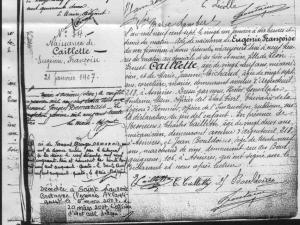Tags
administration, archives, baptism, birth, burial, calendar, death, family history, france, genealogy, history, Holy See, marriage, parrish, records, revolution
As per my previous post, the French Revolution had a huge influence on the way each French people’s life events were recorded.
1 – 1792, When Man’s existance means something
During the Monarchy (before 1792), Men are not important and only the institution and Kingdom matter. In the Judicial archives for instance (legal trials etc.) you will never find any nominative lists of people, so it is nearly impossible to find any particular document unless you know the exact date of the event!
In opposition, the first word of the Declaration of Human Rights (1789) is “Les Hommes” (“Men“).
From this moment, Men, Women and Children are not only equal before the law but are considered as a full part of the system and the same respect should be given to them as the one given to the Nation.
As a consequence and as explained, in terms of civil records, the way civil administration worked changed from the pre-revolution period. This learning is of course key to ease and optimize researches in French records. We said that:
- all birth, marriages and deaths are to be recorded regardless of religion.
- The Republican Calendar is implemented and replaces the Gregorian calendar used all over the World.
- The “Tables Décennales” are implemented to ease the work of civil servants, and consequently
We also said that in general the idea was to unify the country and apply the same standards to every citizen. It is the case of the information found in any civil records for instance. We can say that in comparison with Parrish records it is day and night.
- Whether you are a peasant or from Nobility, your records will be identical. They will both contain the same type of information.
- Templates are created so the civil servants only have “to fill in the blanks”. No personal note!
- The type of information found in the documents are much more informative.
*For a birth record for instance:
– Exact place of birth
– Age or date and place of birth of the parents
– Occupation of the parents
– Address of the parents
– If the father is dead, place and date of death
– the information of 1 or 2 witnesses (often family related)
*For a Marriage record the same information as above for both the groom and the bride with in addition their own place and date of birth.
*Finally, the death record, will also provide information on the spouse/ husband and whether he/ she is still alive and if not when and where he/she died.
- The records are always in French language since the duty of civil servant is only given to people who could read and write (the Mayor usually who is often from a reach family who could afford to send the children to school).
2 – When a birth record becomes a Curriculum Vitae
The 19th and 20th Century was for France two centuries of wars, enlargement of the Colonial territories, political turmoil…Between 1804 and 1871, France had three Revolutions (1832, 1848, 1871), three very important military campaigns (Napoleon’s war 1799-1815, “African Pacification” 1849, Crimea 1855), one invasion of its Territory (Prussia 1870 and the loss of Alsace & Lorraine).
Many men are called to fight around the World, many die. Widows, heirs and the administration need to be able to locate all the information quickly of any given individual.
In order to simplify the research, French administration decided to use the same system as the one used in the French Royal Navy (I guess not everything was bad!).
On a ship, the “Crew Roles” were books where were recorded the name of the each crew and their “role” on board: sailor, steersman, carpenter etc.
When one of this man died, the date and place of death would be written in the margin next to his name.
From 1804, French administration adopted the same idea to state different events on the birth records. These are called “mentions marginales” (“In Margin Annotations“). From then many type of information have been added to the list of Mentions Marginales. Here are some important ones:

Birth record of my Grand-mother (1907), in the margin: Marriage (1933), divorce (1954) and death details (2007).
- 1804: Recognition of a Natural Child
- 1886: Divorce (first put only on the marriage record, then put on the birth record)
- 1895: Marriage
- 1945: Death
- 1955: Adoption
for each event, you have the place and the date of the event… all this in one record!
This will make the next generations of genealogists’ life SO easy (if there is still paper of course!)
(end of Part 2. Next post – The Military sources, so much information can be found)

